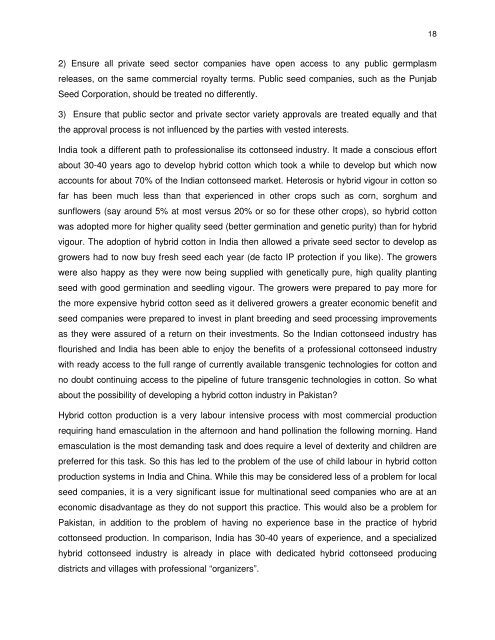ChangingCottonLandscapeNeilForrester
ChangingCottonLandscapeNeilForrester
ChangingCottonLandscapeNeilForrester
Create successful ePaper yourself
Turn your PDF publications into a flip-book with our unique Google optimized e-Paper software.
2) Ensure all private seed sector companies have open access to any public germplasm<br />
releases, on the same commercial royalty terms. Public seed companies, such as the Punjab<br />
Seed Corporation, should be treated no differently.<br />
3) Ensure that public sector and private sector variety approvals are treated equally and that<br />
the approval process is not influenced by the parties with vested interests.<br />
India took a different path to professionalise its cottonseed industry. It made a conscious effort<br />
about 30-40 years ago to develop hybrid cotton which took a while to develop but which now<br />
accounts for about 70% of the Indian cottonseed market. Heterosis or hybrid vigour in cotton so<br />
far has been much less than that experienced in other crops such as corn, sorghum and<br />
sunflowers (say around 5% at most versus 20% or so for these other crops), so hybrid cotton<br />
was adopted more for higher quality seed (better germination and genetic purity) than for hybrid<br />
vigour. The adoption of hybrid cotton in India then allowed a private seed sector to develop as<br />
growers had to now buy fresh seed each year (de facto IP protection if you like). The growers<br />
were also happy as they were now being supplied with genetically pure, high quality planting<br />
seed with good germination and seedling vigour. The growers were prepared to pay more for<br />
the more expensive hybrid cotton seed as it delivered growers a greater economic benefit and<br />
seed companies were prepared to invest in plant breeding and seed processing improvements<br />
as they were assured of a return on their investments. So the Indian cottonseed industry has<br />
flourished and India has been able to enjoy the benefits of a professional cottonseed industry<br />
with ready access to the full range of currently available transgenic technologies for cotton and<br />
no doubt continuing access to the pipeline of future transgenic technologies in cotton. So what<br />
about the possibility of developing a hybrid cotton industry in Pakistan?<br />
Hybrid cotton production is a very labour intensive process with most commercial production<br />
requiring hand emasculation in the afternoon and hand pollination the following morning. Hand<br />
emasculation is the most demanding task and does require a level of dexterity and children are<br />
preferred for this task. So this has led to the problem of the use of child labour in hybrid cotton<br />
production systems in India and China. While this may be considered less of a problem for local<br />
seed companies, it is a very significant issue for multinational seed companies who are at an<br />
economic disadvantage as they do not support this practice. This would also be a problem for<br />
Pakistan, in addition to the problem of having no experience base in the practice of hybrid<br />
cottonseed production. In comparison, India has 30-40 years of experience, and a specialized<br />
hybrid cottonseed industry is already in place with dedicated hybrid cottonseed producing<br />
districts and villages with professional “organizers”.<br />
18


